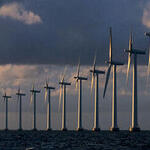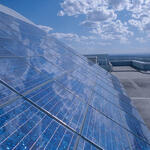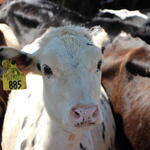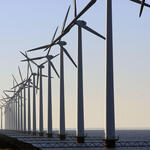- Date: 13 September 2018
- Author: Sam Arons, Director of Sustainability at Lyft
Since 2017, World Wildlife Fund (WWF) has been part of Lyft’s Round Up & Donate program, which gives Lyft riders the option to round up their fare to the next dollar and donate the difference to WWF.
This year, Lyft’s been working to reduce its carbon footprint. As the Global Climate Action Summit (GCAS) takes place in San Francisco this week, WWF caught up with Lyft’s Director of Sustainability, Sam Arons, to learn more about the company’s commitments.

Why does Lyft care about its environmental impact and making climate commitments?
Lyft was founded on the belief that technology will enable us to dramatically reduce carbon emissions from the transportation system while improving quality of life and access to opportunity for all Americans. We’re more determined now than ever before to make that vision a reality. We now give more than 10 million rides a week - and as we continue to grow, we have a greater responsibility to dedicate material resources to our vision and values.
In the future, all vehicles will be electric and operate using clean electricity. But climate change is not waiting. It’s happening now, and it presents a clear and immediate threat to our world and those who live in it. Action cannot wait. That's why we took the important steps to immediately offset the carbon emissions from all rides globally - and earlier this week, we announced that Lyft is now a fully carbon neutral company. We have also committed to purchase enough renewable energy to cover the electricity consumption of every Lyft office space, driver hub, and electric vehicle mile on our platform.
These actions are not the full solution, but an important step forward. By committing significant financial resources to these efforts, we’re building into our business a strong incentive to pursue shared rides and the displacement of gasoline-powered vehicles. The more shared rides and clean vehicles on the platform, the fewer carbon offsets we will need to purchase.
As a company whose business model relies on cars, what steps are you taking to reduce emissions?
Back in April, just before Earth Day, Lyft announced that we would be offsetting the carbon emissions from our rides And this week for GCAS, we’ve doubled down on that commitment by announcing that Lyft is now a fully carbon neutral company, and that we’re covering 100% of our electricity consumption, including EV charging, with renewable energy. What we’ve effectively done is imposed a carbon price on ourselves as a way to drive CO2 out of our business. We’re excited about this for a few reasons. First of all, we think it’s important to take responsibility for our environmental impact, and this was a way to step up and do that right away.
How do you plan to achieve your carbon offset commitment?
When we started this project, we obtained a partner to help us build a portfolio of offset projects that would be in the right places and volumes to offset all ride emissions. These offset projects were selected after rigorous vetting. That’s how we kicked off the project. Since the announcement and selecting the projects, we have been buying the offsets on an ongoing basis to cover the emissions as they occur.
Do you work with others across industry? If so, what steps are you taking to drive the industry forward?
“We’re already starting to have the conversations that will bring a whole ecosystem of different players together to achieve this electrified future.”
Sam Arons
Director of Sustainability at Lyft
Lyft is part of several different industries, two major ones being the transportation industry and the tech industry. It’s important to us to work across both, and with our colleagues in local and state governments. One area where this will be particularly important is with electric vehicles. EVs will be a very important piece in the future of our sustainability program at Lyft. At the end of the day, it’s good to be offsetting carbon emissions, and we’re very proud that we’re doing that, but that can’t be the ultimate answer. We need to eliminate emissions to begin with rather than emit and then have to offset. To do that, we’ll need all our rides to be in electric vehicles that are charged from renewable energy to have no emissions at all. Achieving this will require working with auto manufacturers who will be the ones to create more models of vehicles that have sufficient range for a ride-sharing application – about 200 miles at a minimum. We’ll also work with electric utilities who will provide the grid infrastructure that can support more charging stations, and with third-party charging providers to get those stations deployed. And we’ll need to work with state and local governments on permitting and placement of charging stations. We’re already starting to have the conversations that will bring a whole ecosystem of different players together to achieve this electrified future.
_____________________________________________________________________________________________________
The views expressed in this blog do not necessarily reflect those of WWF.
- Date: 01 January 2018
- Author: Jason Clay, SVP Markets, Exec Director of the Markets Institute
The Markets Institute at WWF identifies global issues, trends, and tools around the most pressing challenges of our time. Each year we release a list of what we see as the top emerging industry developments that may not be apparent to help stakeholders stay ahead of the curve, and to help us all shift faster.
The lists are identified through research, interviews, data analysis, and discussions with our Thought Leader Group. Here are the top issues, trends, and tools to keep an eye on in 2018:
ISSUES
Trade wars
With the recent resurfacing of nationalism around the world, we should expect an increase in trade wars as countries use trade to negotiate many different issues including global parity around cost of production as well as positioning countries to support domestic political platforms and constituencies. If/when trade wars come to include food—whether to close borders entirely or even just limit exports—then it will most certainly cause environmental impacts.
Plastics and food waste
The rush to limit plastic in the environment and particularly plastic ending up in the oceans is unprecedented. The full extent of the environmental impacts of plastic are only beginning to be understood. However, plastic does have several benefits, especially when it comes to food in terms of both safety and improved storage life. We need to be careful that we don’t move so far to remove plastics that we begin to increase food loss and waste. We need to find ways to recreate the benefits and convenience of plastic, or we need to find ways to keep plastics out of the environment or both.
From traceability to transparency
For several years, companies have become more and more interested in where their products are produced. Certification and verification systems do this (to some extent), but they are expensive and often proprietary, so many different systems have been created including—but not limited to—Blockchain. The traceability systems, however, rarely go all the way to the farm where production happens, or even further back to feed and other inputs. And now companies are beginning to realize that it is probably more important to know how the product is produced as where it is produced.
The rise of urban and controlled environment agriculture
There are hundreds of vertical, soilless agriculture operations in the US and thousands around the world. These operations offer the opportunity of producing food in urban areas, in food deserts, and in areas with severe water shortages. They also have the potential to reduce food loss and increase shelf life. While the number of species grown is still rather small and dominated by leafy greens, it is broadening. The cost of production remains high, but the operations are akin to that of solar and wind power in the 1970s. As the industry grows and people innovate, the costs will go down and these systems will be more affordable and more versatile. Even better if the actors can share knowledge on certain technology and grow more quickly through collaboration.
Finance resilience
The impacts of climate change, both chronic and extreme weather events, have occurred more quickly than anyone thought. We are already seeing undeniable impacts on production, livelihoods, and nutrition. Two places where this is most pronounced are with smallholder producers of tree crops: cocoa in West Africa and coffee in Central America. Many producers are beginning to struggle as their products and production systems falter in the face of unpredictable rains and drought and the spread of pests and diseases. Governments have generally reduced funding for food and agriculture just when they need to be increasing it. Companies need to find ways to invest in the producers in their supply chains not just for traceability and transparency but also for resiliency.
Cyber warfare, food security
To date, cyber-attacks have largely ignored food and food security targets. However, as food delivery via e-commerce platforms grows, the potential for cyber-attacks increases. As trade becomes more politicized, food production also becomes a bigger target. Finally, as food productions increasingly depends on electricity or digitally based systems for irrigation, feeding, or detection, cyber warfare targeting food systems will become a lot more common.
TRENDS
Food e-commerce
E-commerce for food has grown considerably in recent years. It started with fast food delivery services like pizza in the US. But it has expanded to include uncooked food home delivery, mostly in China starting with Alibaba, and then on to the US with Amazon, Blue Apron, and more. Some grocery retailers have been delivering food for over a decade and they are stepping up the pace to compete. This trend will only expand.
Changing consumption patterns
Consumption patterns have shifted for as long as people have been exposed to different foods and types of cuisine. This of course increased as mass transportation became more common, and it has increased even more as social media has connected people around the world through food. Today, health and nutrition concerns, as well as age also influence consumption. However, as food becomes more global and even niche markets can be quite large, global finance is also increasing the pace and scale of change. When coupled with high net worth individuals with strong food preferences and opinions, even more funding becomes available.
M&A over R&D
In the face of climate change, the rise of nationalism and increasing trade wars, companies are investing increasing amounts in mergers and acquisitions and less in research and development. It is cheaper to buy innovation and market share than it is to build it out from scratch. There are simply too many things that can be relevant to a viable company today than ever before.
Go North (or South), young man
Climate change is driving chronic changes in crop growing zones, winter freezes, and average rainfall as well as increasing extreme weather like hurricanes, droughts, floods, fires, and dust bowls. Crops are moving North in North America but also in Europe and Asia, and South in Africa and Latin America. And habitat conversion continues and GHG emissions increase.
Precompetitive platform uptake
The number of precompetitive platforms has increased rapidly as companies begin to realize that many of the most important issues they must address are shared with others, as are the solutions. Sustainability is a precompetitive issue. Companies are responsible for what they do directly, however, most of the biggest impact of food products are where and how raw materials are produced and then consumed. What happens in the middle has fewer impacts. No company can solve production and consumption issues alone. Climate change and other crises will spur more collaboration.
TOOLS
Common protein and nutrition metrics
As questions on healthier and more nutritious diets become more common, calories will no longer be a sufficient metric for malnourishment. We need a common set of metrics to compare proteins and other key nutrients from very different kinds of foods so that we can compare apples to apples, so to speak. Many plants have proteins—are they the right ones? Many animal proteins have nutrients—are they the right ones? At what ages are different proteins and nutrients most important in human lives? How many of these proteins and nutrients already exist in household gardens of local communities and indigenous people but have never been studied by science? Is there a way to create averages or ranges, or is every individual truly unique?
CRISPR & gene editing
CRISPR and other types of gene editing allow for the selection and replication of traits that already exist within a genome, e.g. productivity, flavor profiles, and nutrient density. However, they are also tools that can be used to help make organisms more resilient in the face of climate change, e.g. drought or heat tolerance, disease resistance, or geographic and conditional variation. These same tools can be used to create GMOs, but their benefits can also come from working on single species. Whether that happens or not in some geographies will depend on if gene editing within a species is considered a GMO or not. Portable DNA sequencers are another genetic tool to keep an eye on, with potential for hunting down pests, testing for viruses, and bringing science directly into the hands of farmers.
Agrobots and tech
There have been a plethora of new robotic and other technology developments along the value chain. Drones monitor field conditions including soil moisture, plant health, and disease outbreaks at a fraction of the costs of humans, and very quickly with higher levels of certainty. Tractors drive themselves while also geo-spatially monitoring seeding rates and fertilizer applications, herbicide applications and pest issues, and productivity tied back to inputs used. Agrobots can be used to help determine optimal harvest times and increasingly, harvesting can be automated. Finally, distribution centers are automated and home food deliveries can be made by bots. There’s no question this will be a multibillion dollar industry in short order, but how it will impact labor and if/when it will price some farmers out of the business remains to be seen.
Science-based targets for supply chains
Many companies are making commitments to reduce GHG emissions to help limit global warming to below 2 degrees Celsius. They have started with scope 1 emissions (what they produce themselves onsite) and scope 2 emissions (the energy they purchase). However, in the food industry, scope 3 emissions (how raw materials are produced upstream and how products are consumed) are by far the largest contribution. As we have seen with other certification programs, making commitments is one thing, making change happen is quite another. If the food sector is going to make a meaningful contribution to prevent climate change, we need to find the right incentives.
Social media and misinformation
Social media has allowed the spread of misinformation at unprecedented levels. Couple that with the fact that more people seem to be driven by their own opinions or those of trusted friends than they are by science, and there’s a perfect storm of misinformation. This is a minefield for anyone interested in science-based solutions for the world’s most pressing problems, but it is increasingly difficult for government and the private sector to navigate this space. Social media and the underlying technology are powering the spread of misinformation, and at the end of the day the platforms intended to bring us together are leading to social polarization.
---
Stay tuned for what else we see this year, and help us keep an eye on the horizon.
If you haven't already, sign up for our weekly update to see how these trends evolve.
- Date: 03 December 2015
Part of New Commitment to Power the Internet with Renewable Energy
Today, Google announced a series of major renewable energy agreements and signed on to the Renewable Energy Buyers’ Principles. Here’s more about the purchases and the company’s commitment to powering the future clean energy from the official Google blog:
“…we’re announcing the largest, and most diverse, purchase of renewable energy ever made by a non-utility company. Google has already committed to purchase more renewable energy than any other company. Now, through a series of new wind and solar projects around the world, we’re one step closer to our commitment to triple our purchases of renewable energy by 2025 and our goal of powering 100% of our operations with clean energy.
842 MW of renewable energy around the world
Today’s agreements will add an additional 842 megawatts of renewable energy capacity to power our data centers. Across three countries, we’re nearly doubling the amount of renewable energy we’ve purchased to date. We’re now up to 2 gigawatts—the equivalent to taking nearly 1 million cars off the road.
These additional 842 megawatts represent a range of locations and technologies, from a wind farm in Sweden to a solar plant in Chile.”
- Date: 05 October 2015
Africa is home to some of the fastest-growing economies on the planet, with an expected growth rate of 4.5 percent in 2015 and 5 percent in 2016. But the lack of affordable, reliable energy could challenge continued economic and social development.
Because Africa’s population and economic growth are outpacing electrification efforts, the number of people without access to electricity is expected to grow from 585 million to 645 million by 2030; that’s more than twice the current population of the United States simply left behind.
The conventional approach to electrification on the continent mainly seeks to expand access to the centralized grid, and that will not be enough. The International Energy Agency estimates that in Africa, nearly half of the 315 million people who live in rural areas will depend on off-grid solutions, like mini-grids, to close the electricity gap, while a quarter of those who live in the remote rural areas will rely on smaller, stand-alone solutions like solar home systems for first-time energy access.
To achieve universal energy access by 2030, Africa needs an integrated approach that expands the grid while massively scaling up distributed generation (DG) -- modular systems that generate power close to where it is used. These include stand-alone systems, as well as mini-grids, which may be off-grid or grid connected.
Reaching Sustainable Development Goals through Distributed Generation
The Sustainable Development Goals (SDGs), just adopted at the United Nations, acknowledge this growing energy gap in goal number 7, which sets a target of universal access to affordable, reliable, modern energy services within the next 15 years. These new goals – which aim to eradicate extreme poverty in an environmentally sustainable way -- emphasize the role of energy access as a means to that end. The SDGs also stress the importance of empowering and fully engaging civil society, the private sector, and – most importantly – the energy users themselves in developing energy access solutions.
WRI, WWF and Prayas Energy Group have developed a new resource, 10 Questions to Ask about Distributed Generation, which can serve as a valuable tool for countries seeking to tap into distributed energy sources to provide access to affordable, reliable, sustainable and modern energy. The tool has been designed to assist stakeholders to better understand and make meaningful contributions to the energy planning processes in ways that will significantly impact the effectiveness of energy access initiatives and produce tangible development impacts.
Distributed Generation ("DG") Can Play a Role
With the cost of renewable energy technologies continuing to decline, and with the DG market witnessing truly transformational innovations – such as mobile money-enabled pay-as-you-go business models -- the market opportunity in Africa is tremendous. Yet, the use of DG is still limited in Africa; energy service providers are faced with significant challenges as they try to scale their impact. How do service providers better tailor their services to the needs of the households, businesses and communities that they are trying to serve? How do they ensure the provision of high quality energy services at affordable prices? How does the regulatory and planning environment impact the cost of energy services? How does the regulatory and planning process allow for smooth integration of distributed generation services into the grid?
The complexity of these challenges means that a wide network of actors must be engaged to collectively define energy needs and manage cost-effective and sustainable energy solutions. Decision-makers and planners, as well as civil society groups, development partners and investors, must not only more fully appreciate the contribution DG can make towards achieving energy objectives, but must also work together to create a supportive framework for its rapid expansion and integration into national energy plans.
This tool can be used to facilitate effective communication between stakeholders, discover knowledge gaps and develop collaborative research agendas. In the coming months, the tool will be put to use in Africa, where WWF and WRI are partnering to ensure that civil society, energy service providers, and other relevant stakeholders have a seat at the table to improve energy planning and program implementation. Through its local country offices in Kenya, Uganda and Tanzania, WWF is developing networks and Sustainable Energy Forums. Through these structures, the 10 Questions to Ask about Distributed Generation will be used to help diverse constituencies work through complex, multifaceted and in some cases, divisive issues around priority setting and planning for energy access.
This framework will be a valuable tool as countries begin to pursue Sustainable Development Goal number 7 and move towards implementing Sustainable Energy for All country action agendas as well as national, district and local energy plans.
The 10 Questions to Ask about Distributed Generation is part of a 4 part WRI’s 10 Questions series.
For additional information please contact Daniel Riley, Lead Specialist for Renewable Energy Policy at WWF
- Date: 02 September 2015
- Author: Matt Banks
In August, the US Environmental Protection Agency (EPA) and President Obama announced the final Clean Power Plan, aiming to reduce carbon pollution from power plants across the nation. A safer and more prosperous future is within our grasp and on the horizon. To reach it, both governments and the private sector need to work together. Governments have made a major step with the Clean Power Plan. Businesses can match this step by committing to a zero-carbon future powered by renewable energy. The easiest place to start? A proven strategy designed by WWF, CDP and McKinsey & Co. that can save both money and carbon through:
- Energy efficiency through technology improvements
- Energy efficiency through management or behavioral changes
- Increased use of low-carbon energy
- Date: 01 May 2015
- Author: James Beard, WWF and Rafael A Grillo Avila, Environmental Defense Fund
If international aviation were a country, it would be a global top ten carbon emitter, with emissions expected to triple or quadruple by 2040. This is why the International Civil Aviation Organization (ICAO) has agreed to cap net carbon emissions from international aviation at 2020 levels.
ICAO aims to achieve this goal through technical and operational measures; carbon pricing through market-based measures (MBM’s); and biofuels. Many airlines see biofuels as a “silver bullet” for meeting their carbon goals. Already over 40 airlines have flown over 600,000 biofuel-powered flights.
- Date: 17 February 2015
The Buyers’ Principles were launched by WWF and the World Resources Institute (WRI) in July, 2014 with 12 major companies. Word continues to spread and there are now 25 signatories.
- Date: 31 July 2014
- Author: Sandra Vijn, WWF
There’s another energy revolution developing from the most unlikely of places – cow manure
Today, President Obama released a “Biogas Opportunities Roadmap”, as part of the administration’s Climate Action Plan - Strategy to Reduce Methane Emissions. The Roadmap promotes the market potential and benefits of biogas and encourages the adoption of closed-looped biogas systems. In action, this is collecting cow manure and allowing it to ferment in a sealed tank. The methane released during fermentation is captured and used for energy. In a closed-loop system, the “cooked” manure – essentially sterilized -- is separated into liquid and solid. The liquid is used as crop fertilizer and the solids can be used as cow bedding or compost.
- Date: 28 July 2014
- Author: By Joshua Ryor, World Resources Institute (WRI) and Bryn Baker, World Wildlife Fund (WWF)
Earlier this month, Walmart and 11 other major companies announced their commitment to a set of Corporate Renewable Energy Buyers’ Principles that outline how renewable energy providers and utilities can help meet the growing corporate demand for renewable energy.
- Date: 11 July 2014
- Author: Marty Spitzer, Director US Climate and Renewable Energy Policy, WWF
What can rotary dial telephones, cathode ray tube (CRT) televisions and door to door milk delivery teach us about the renewable energy revolution? They show us how once commonplace products and services have and will always be replaced by newer ones. It’s not farfetched to say 2014 is to renewable energy what 1955 was to the CRT TV – the golden age of renewable energy is just now upon us.









